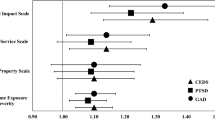Abstract
This study examined psychological distress and functioning among Hurricane Andrew victims who lost their homes and were living in shelters. Four and one-half weeks after Hurricane Andrew struck southern Florida, 89 (45 males, 44 females) Blacks, Hispanics, and Whites completed a questionnaire. The questionnaire asked for information about psychological and psychophysiological symptoms, use of mental health services, coping responses, and extent of preparation for the storm. The findings suggest that loss of home and property were related to distress and depression. About one-quarter of the sample were moderately depressed. Over one-third of the sample reported experiencing psychological and psychophysiological distress. Approximately one-half of the subjects did not take the hurricane warnings seriously. White subjects began preparing earlier for the storm, and evacuated their homes more frequently than did Black subjects. Implications of the findings and future research directions are discussed.
Similar content being viewed by others
References
Allen, R. D. (1993). Organizing mental health services following disaster: A community systems perspective. In R. Allen (Ed.),Journal of Social Behavior and Personality, 8, 179–188.
Berndt, D. J. (1986). Multiscore Depression Inventory Manual. Western Psychological Services, Los Angeles.
Berndt, D. J., Petzel, T. P., & Kaiser, C. F. (1983). Evaluation of a short form of the Multiscore Depression Inventory.Journal of Consulting and Clinical Psychology, 51, 790–791.
Berndt, D. J., Berndt, S. M., & Kaiser, C. F. (1984). Multidimensional assessment of depression.Journal of Personality Assessment, 48, 489–494.
Carlson, E. B., & Rosser-Hogan, R. (1994). Cross-cultural response to trauma: A study of traumatic experiences and posttraumatic symptoms in Cambodian refugees.Journal of Traumatic Stress, 7, 43–56.
Freedy, J. R., Shaw, D., Jarrell, M. P., & Masters, C. (1992). Towards an understanding of the psychological impact of natural disaster: An application of the conservation resources stress model.Journal of Traumatic Stress, 5, 441–454.
Freedy, J. R., Kilpatrick, D. G., & Resnick, H. S. (1993). Natural disasters and mental health: Theory, assessment, and intervention.Journal of Social Behavior and Personality, 8, 49–103.
Gibbs, M. S. (1989). Factors in the victim that mediate between disaster and psychopathology: A review.Journal of Traumatic Stress, 2, 489–515.
Gibbs, M. S., Drummond, J., & Lachenmeyer, J. R. (1993). Effects of disasters on emergency workers: A review, with implications for training and postdisaster interventions.Journal of Social Behavior and Personality, 8, 189–212.
Gleser, G. C., Green, B. L., & Winget, C. N. (1981).Prolonged psychosocial effects of disaster: A study of Buffalo Creek. New York: Academic Press.
Green, B. L. (1990). Defining trauma: Terminology and generic Stressor dimensions.Journal of Applied Social Psychology, 20, 1632–1642.
Green, B. L. (in press). Cross-national and ethnocultural issues in disaster research. In A. Marsella, M. Friedman, E. Gerrity, & R. Scurfield (Eds.),Ethnocultural aspects of post-traumatic stress disorders. Washington, D.C.: American Psychological Association.
Green, B. L., & Solomon, S. D. (in press). The mental health impact of natural and technological disasters. In J. R. Freedy & S. E. Hobfoll (Eds.),Traumatic stress: From theory to practice. New York: Plenum Press.
Hobfoll, S. (1989). Conservation of resources: A new attempt at conceptualizing stress.American Psychologist, 44, 513–524.
Hobfoll, S. (1989). Conservation of resources: A new attempt at conceptualizing stress.American Psychologist, 44, 513–524.
Kaniasty, K. Z., Norris, F. H., & Murrell, S. A. (1990). Received and perceived social support following natural disaster.Journal of Applied Social Psychology, 20, 85–114.
Lima, B. R., Pai, S., Santacruz, H., & Lozano, J. (1991). Psychiatric disorders among poor victims following a major disaster: Armero, Columbia.Journal of Nervous and Mental Disease, 179, 420–427.
Maida, C. A., Gordon, N. S., Steinberg, A., & Gordon, G. (1989). Psychosocial impact of disasters: Victims of the Baldwin Hills fire.Journal of Traumatic Stress, 2, 37–48.
Moore, H. E. (1958).Tornadoes over Texas. Austin, TX: University of Texas Press.
Mullins, S. (September 20, 1992). Andrew recovery is slow.Post and Courier, p. A1.
National Oceanic and Atmospheric Administration (1993).Hurricane: A familiarization booklet. Washington, D.C.: U.S. Department of Commerce.
Nigg, J. M. (1982). Awareness and behavior: Public response to prediction awareness. In T. F. Saarinen (Ed.),Perspectives on increasing hazard awareness (pp. 70–96). Boulder, CO: University of Colorado Institute of Behavioral Science.
Rohter, L. (November 6, 1992). A hurricane's long lasting impact.New York Times, p. A8.
Rubonis, A. V., & Bickman, L. (1991). Psychological impairment in the wake of disaster: The disaster-psychopathology relationship.Psychological Bulletin, 109, 384–399.
Sattler, D. N., & Freedy, J. R. (in press). Natural Disasters and Mental Health: Implications of Research for Prevention Efforts.Proceedings of The International Emergency Management and Engineering Society, USA.
Shechet, A. L., & Jordan, C. E. (1993). The Kentucky posttrauma response team: Development of a statewide crisis response capability.Journal of Social Behavior and Personality, 8, 267–280.
Shore, J., Tatum, E., & Vollmer, W. (1986). Psychiatric reactions to disaster: The Mount St. Helens experience.American Journal of Psychiatry, 143, 590–595.
Solomon, S. (1989). Research issues in assessing disaster's effects. In R. Gist & B. Lubin (Eds.),Psychosocial aspects of disaster (pp. 308–340). New York: Wiley & Sons.
Steinglass, P., & Gerrity, E. (1990). Natural disasters and post-traumatic stress disorder: Short-term versus long-term recovery in two disaster-affected communities.Journal of Applied Social Psychology, 20, 1746–1765.
Turner, R., Nigg, J., Paz, D., & Young, B. (1979).Community response to earthquake threat in southern California. Los Angeles: University of California, Los Angeles.
Weiss, D. S. (1993). Psychological processes in traumatic stress. In R. Allen (Ed.),Journal of Social Behavior and Personality,8, 3–28.
Wright, G., & Philips, L. (1980). Cultural variation in probabilistic thinking: Alternative ways of dealing with uncertainty.International Journal of Psychology, 15, 239–257.
Author information
Authors and Affiliations
Rights and permissions
About this article
Cite this article
Sattler, D.N., Sattler, J.M., Kaiser, C. et al. Hurricane Andrew: Psychological distress among shelter victims. Int J Stress Manage 2, 133–143 (1995). https://doi.org/10.1007/BF01740299
Issue Date:
DOI: https://doi.org/10.1007/BF01740299




